Correction: Addressing energy storage needs at lower cost via on-site thermal energy storage in buildings
Publication Type
Date Published
Authors
DOI
Abstract
Cost-effective energy storage is a critical enabler for the large-scale deployment of renewable electricity. Significant resources have been directed toward developing cost-effective energy storage, with research and development efforts dominated by work on lithium ion (Li-ion) battery technology. Though Li-ion batteries have many attractive qualities, it is not clear whether they can provide an affordable levelized cost of storage (LCOS) for certain applications, such as buildings. Buildings consume most of the world's electricity, and as much as 50% of their consumption goes toward meeting thermal loads. Thermal energy storage (TES) can provide a cost-effective alternative to Li-ion batteries for buildings; however, two questions remain to be answered. First, how much of total building energy storage requirements can be met via thermal storage for building loads? Second, can the LCOS for TES be favorable compared with Li-ion batteries? In this perspective, using the United States as a case study, we show that the total requirement for TES in buildings is in the range of ∼1200–4500 electrical GW h, depending on the fraction of solar versus wind in the generation mix. Furthermore, we show that with at least 25% wind generation, all of the storage needed by buildings to support the grid can be met by TES. We also introduce a framework to calculate LCOS for on-site TES in buildings to enable a direct comparison with electrical storage technologies such as Li-ion batteries. This is not trivial, because the input energy type for TES (electricity) differs from the output energy type (thermal energy), and the efficiency can depend on ambient conditions. Our LCOS analysis shows that in many situations, TES can be more cost-effective for buildings than Li-ion batteries. We conclude our perspective by discussing future research and development opportunities that can significantly advance the deployment of TES for buildings to help enable a renewable electricity-dependent grid.
Correction for ‘Addressing energy storage needs at lower cost via on-site thermal energy storage in buildings’ by Adewale Odukomaiya et al., Energy Environ. Sci., 2021, 14, 5315–5329, DOI: 10.1039/D1EE01992A.
There were errors in the insets of Fig. 5d–f. The orange lines should have been labelled COPC/COPav = 1; the grey lines COPC/COPav = 1.5; and the blue lines COPC/COPav = 2. The figure should have appeared as follows:
